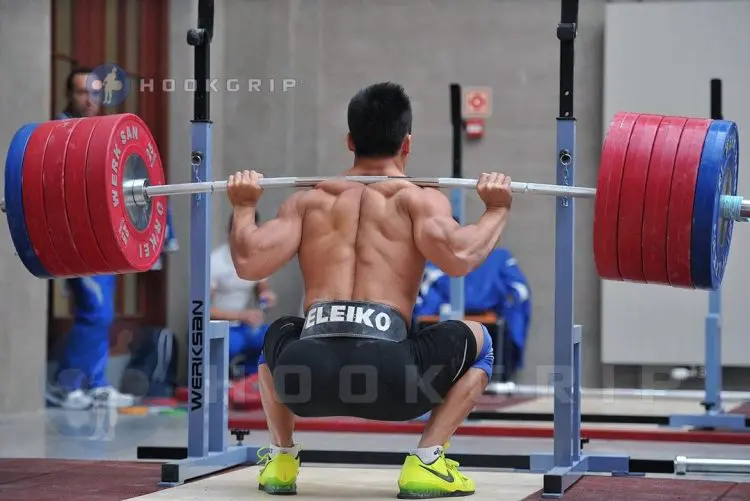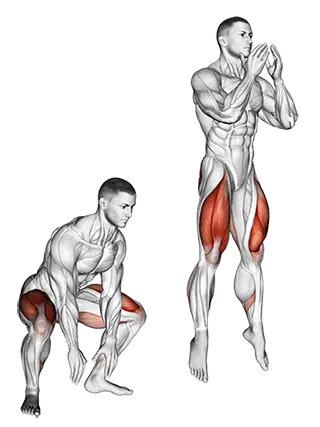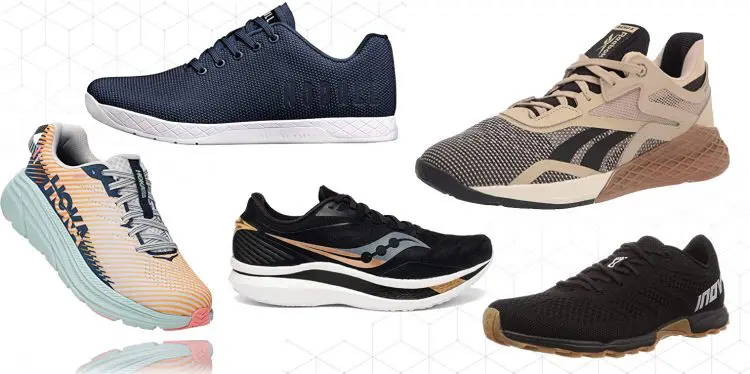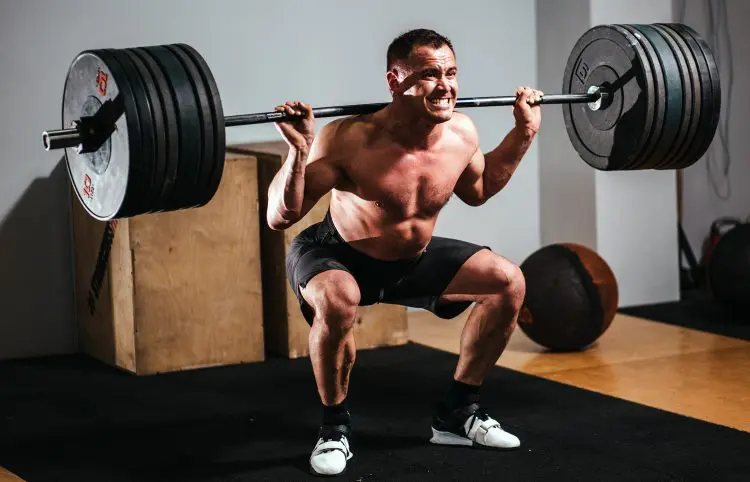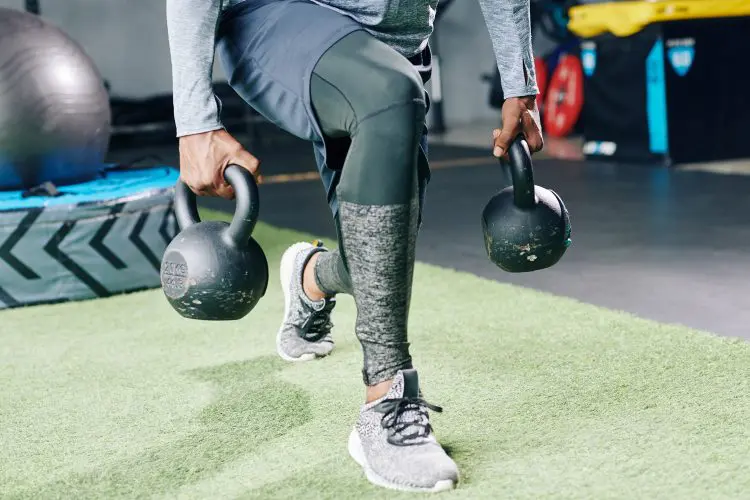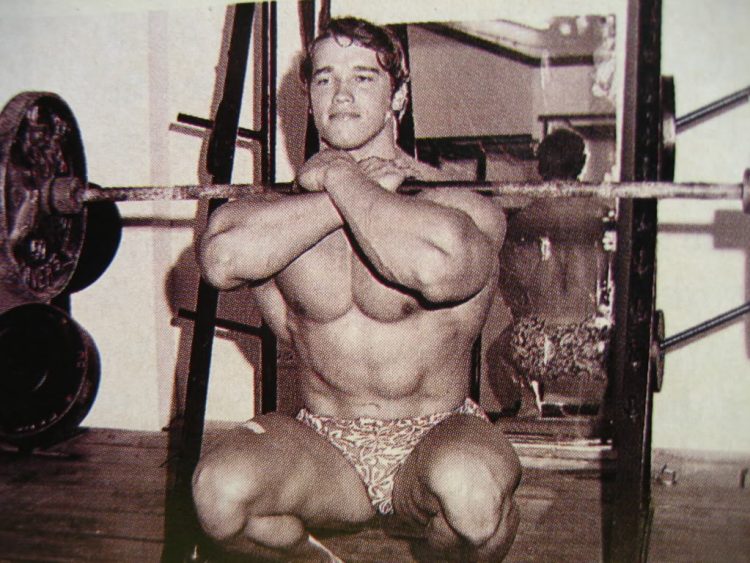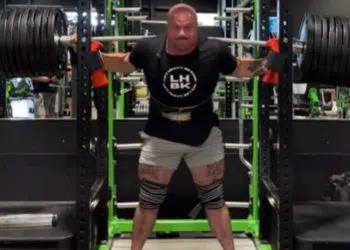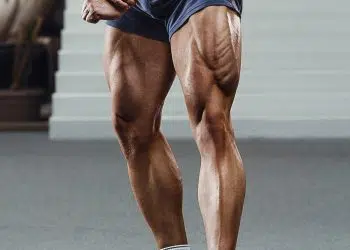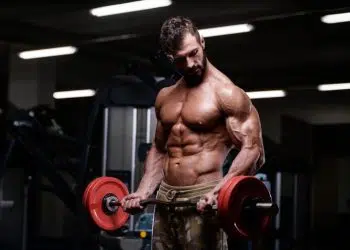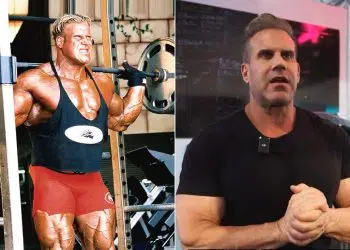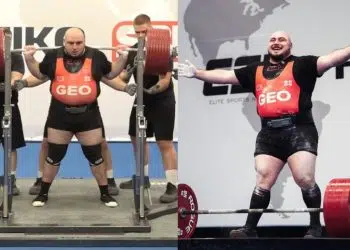If you could only do one leg exercise from now until the end of time, squats should probably be the one you choose. In terms of lower body muscle engagement, squats are hard to beat, as they work virtually every muscle in your legs.
Squats also provide your core and some of your upper body muscles with a good workout. It’s no wonder that squats are often called the king of exercises!
But squats are not an easy exercise to master, and they require good mobility and positional awareness to do correctly. Improper squatting can lead to serious injury, not to mention long-term knee pain.
While there is nothing wrong with treating the squat as “just another exercise,” some lifters want to take things further and see just how much weight they can squat.
If you want to discover your squat limits, you’ll undoubtedly benefit from some squat-specific training.
In this article, we reveal the 12 best exercises and training methods to improving your squat performance.
Level Up Your Fitness: Join our 💪 strong community in Fitness Volt Newsletter. Get daily inspiration, expert-backed workouts, nutrition tips, the latest in strength sports, and the support you need to reach your goals. Subscribe for free!
12 Strategies to Increase Your Squat
Stuck in a squat rut? Struggling to lift more weight or do more reps? We’re here to help! Use these strategies to get your squat back on track and improve your performance.
However, don’t try and use all these methods at once; that’s a recipe for failure. Instead, use just 2-3 for a month or so and then choose a couple more. That way, you’ll make slow and steady progress instead of burning out.
1. Master the Squat
If your squatting progress has stalled, it could be that you aren’t doing the king of exercises correctly. Poor form could mean you are mechanically inefficient, making the squat harder than it already is. Fixing your technique could automatically boost squat performance and could help prevent squat-related injuries.
Not sure what constitutes good squatting technique? Check out this guide!
1. Strengthen Your Core
While squats are undoubtedly a lower body exercise, your core plays a critical role in squat performance, too. The core is the collective term for the muscles of your midsection, including rectus abdominis, obliques, transverse abdominis, and erector spinae.
These muscles work together to stabilize your spine by creating intra-abdominal pressure, or IAP for short. A strong core will ensure your lumbar spine remains rigid, efficiently transferring the force generated by your legs to your upper body and the weight on your shoulders.
If your core is weak, you may find your hips rising while the weight lags behind. This is both inefficient and potentially dangerous lifting.
Wearing a weightlifting belt can help increase core stability and strength, but direct core strengthening exercises are necessary too. Forget light weight/high-rep core exercises like crunches. The best way to strengthen your core for squats is with low to moderate reps and medium to heavy weights.
Good exercise options include:
2. Strengthen Your Posterior Chain
Squats are a proven quads builder, but they also involve a lot of posterior chain engagement. The posterior chain is the collective term for the muscles on the back of your body, especially the hamstrings, gluteus maximus, and erector spinae.
Strong squats involve keeping your torso relatively upright. If you lean too far forward so that the weight travels beyond your base of support, you are much more likely to fail your lift.
A strong posterior chain will ensure you remain more upright, eliminating one of the most common squatting problems.
Increase posterior chain strength with these effective exercises:
- Romanian deadlifts
- Rack pulls
- Good mornings
- Reverse hyperextensions
- Hyperextensions
- Cable pull-throughs
- Hip thrusts
3. Lift Explosively
Lifting heavy weights is easier when you move faster. Speed helps you blast through sticking points, and momentum means your muscles are under tension for less time. While slow, controlled reps are perfect for building muscle, they will significantly reduce the amount of weight you can lift.
Force generated quickly is called power, and there are plenty of exercises you can do that will boost your power for squats. More muscle power means you’ll be able to blast out of the bottom of your squat, lifting more weight in the process.
Useful lower body power exercises for squats include:
- Squat Jumps
- Power cleans
- Box jumps
- Sumo deadlift high pulls
- Dynamic effort (DE) squats…
To do DE squats:
- Load up the bar with about 50-60% of your one-repetition maximum (1RM)
- Adopt your normal squat stance and brace your abs.
- Descend under control and then, on reaching the bottom of your rep, explode upward and stand up as fast as you can.
- Reset your core and repeat.
- This method works best with 2 to 3-rep sets.
4. Work on Getting Stronger out of The Hole
In powerlifting terms, the hole is the bottom of your squat. A lot of lifters struggle to get out of the hole and fail as a result. The difficulty here is turning an eccentric (muscle lengthening) contraction into a concentric (muscle shortening) contraction. This transition uses a lot of energy as you’re basically trying to decelerate, stop, and accelerate a heavy load. Also, lifting a heavy weight is more challenging than lowering it.
Avoid getting stuck at the bottom of a squat by working on your strength out of the hole.
Valuable exercises for this purpose include:
- Box squats
- Pause squats – pause at the bottom of each rep for 2-3 seconds before standing up
- Anderson squats…
Also known as bottom-up squats and pin squats, Anderson squats are named after famed weightlifter and strongman Paul Anderson. Where regular squats start with your legs straight, this version starts from a deep squat position. This increases explosiveness and strength out of the hole. You’ll need a power rack for this exercise.
How to do it:
- Set your barbell, so it’s resting on the safety bars of your power rack. This should be a deep but manageable squat.
- Duck under the bar and into your squat stance. Get tight, brace your core, and press yourself against the bar. You should feel “wedged in” at the start of your rep.
- Drive up, lifting the bar off the pins, and stand up.
- Descend under control, allow the bar to settle on the pins, and then repeat.
5. Strengthen Your Lockout with Bands or Chains
If you find it hard to lock out your knees at the top of your squat, working with resistance bands or chains will help. Squatting with bands or chains increases the weight as you approach lockout. This is a training method called accommodating resistance.
As well as overloading the upper range of motion, using bands or chains teaches you to lift more explosively and develops your ability to use speed to blast past your sticking points.
Bands and chains have a similar effect. If your gym doesn’t have chains, buy a set of bands and keep them in your workout bag. Bands can also be used for bench presses, deadlifts, and several other exercises.
6. Experiment with Your Squat Stance
Most training literature says to squat with your feet about shoulder-width apart. While that’s not incorrect advice, a wider or narrower stance may suit you better. A lot of powerlifters use a very wide stance for squats as it means a smaller range of motion and that they can use their adductors (inner thighs) more. Olympic lifters can lift HUGE weights using a much narrower stance.
Try varying your squat foot position to see if doing so leads to increases squat performance. Expect your squat to feel a little unnatural at first, but your new stance may allow you to lift more weight as you get used to it.
One way to find your ideal squat stance is to do a single squat jump and notice where your feet land. In a lot of cases, this will be your biomechanically best foot position for squats. At least, it will give you a good starting point for future squat stance adjustments.
7. Wear the Right Shoes
When you are just starting out, you can make good squat progress wearing almost any type of athletic shoe. But, as you get stronger and the weights get heavier, your footwear becomes more important.
Level Up Your Fitness: Join our 💪 strong community in Fitness Volt Newsletter. Get daily inspiration, expert-backed workouts, nutrition tips, the latest in strength sports, and the support you need to reach your goals. Subscribe for free!
Cushioned running shoes will compress under heavy loads, leading to an unstable platform for squatting heavy weights. Needless to say, when you’ve got several hundreds of pounds resting on your upper back, the last thing you need is wobbly feet!
If you are serious about improving your squatting performance, it may be time to upgrade your footwear. Solid soled weightlifting shoes are arguably the best choice, and the raised heel makes it easier to squat deep. CrossFit shoes are also a better option than spongy running shoes.
However, if you squat with a very wide stance, you may find that minimalist shoes with a low heel are better than weightlifting shoes.
8. Squat More Often
If you want to get better at something, you need to do it frequently, and squats are no exception. If you follow a bodybuilding split routine, you probably only squat once a week. However, that may not be often enough if you want to improve your performance. Try squatting twice a week to get stronger, faster.
It would be a mistake to do the exact same squat workout twice a week. That would soon lead to boredom and stalled progress. Instead, do two different squat workouts using a variety of exercises and even different set and rep schemes, for example:
| Squat workout #1 – e.g., Monday | Squat workout #2 – e.g., Thursday | ||
| Back squat | 5 sets of 5 reps | Front squat | 8 sets of 3 reps |
| Paused squat | 4 sets of 4 reps | Squat with bands | 3 sets of 6 reps |
| Leg extensions | 3 sets of 10 reps | Lunges | 3 sets of 8 reps |
| Good mornings | 3 sets of 8 reps | Romanian deadlift | 3 sets of 10 reps |
You can also squat more often than twice a week. In fact, there is a program called the Bulgarian Method that involves squatting every day! While incredibly demanding and aimed at advanced lifters, such a novel training approach could be just what you need to take your squat to the next level.
9. Do Some Unilateral Leg Training
Squats are a bilateral or two-sided exercise. So, it makes sense to include other bilateral leg exercises in your training to boost squat performance, such as leg presses, box jumps, and paused squats, etc.
However, there is value in adding unilateral or single-sided exercises to your squat-enhancing workouts, too.
Even the best lifter usually has one leg stronger than the other, and left-to-right strength imbalances could limit your squat performance. They could even lead to injury. Unilateral exercises can help fix any such imbalances.
Also, unilateral exercises are great for increasing inner and outer thigh engagement, which will lead to more hip and knee stability.
When squatting heavy weights, there is a tendency for the knees to roll in (weak abductors) or out (weak adductors). Both of which will reduce your squat performance and could lead to injuries. Unilateral exercises are an effective way to fix these problems, so you can squat more weight.
There are lots of unilateral leg exercises that will help improve your squat, including lunges, single-leg Romanian deadlifts, and Bulgarian split squats.
Read all about the best unilateral leg exercises here.
10. Try Front Squats
When it comes to squatting big weights, there is a reason that most lifters choose back squats. For starters, resting the weight on your upper back gives you a mechanical advantage, as you can use your glutes and hamstrings more to lift the weight. Also, your upper back and traps provide a natural place to rest the bar.
That said, if your back squat has stalled, try a few weeks or months of front squats to bust out of your training rut.
Front squats emphasize your quads over your hamstrings and glutes and promote a more upright torso. Also, most people find front squats harder than back squats. If nothing else, switching to front squats will provide you with a mental and physical break so that, when you return to back squats, they feel new again.
Learn more about front squats here.
11. Stop Squatting Above Parallel
In an effort to lift more weight, a lot of lifters squat to above parallel. According to powerlifting rules, you must descend until the top surface of your thighs is lower than the top of your knees. Anything less than this is deemed a “no rep.”
While you don’t have to squat “ass to grass,” you should squat to parallel if you are physically able. This ensures that each and every rep you perform uses the same range of motion. Deeper squats are more challenging squats, making them better for increasing your strength and squat performance.
Half-reps are basically cheating, and how can you compare a heavy partial rep with a deeper but lighter rep? That would make measuring performance and improvements almost impossible.
So, monitor your squat depth and always descend to parallel. Don’t be surprised if that’s deeper than you realize, especially if you are used to doing shallower reps. Record yourself side-on to see just how deep you’ve been squatting.
If you are thinking of trying powerlifting, you should learn to squat to parallel without a mirror, as you won’t have one in competition. But, if you have no intention of pulling on a singlet and doing the “barbell triathlon,” it’s fine to squat in front of a mirror to make sure you’re going down far enough. Box squats can also help, as they’ll give you feedback on squat depth.
12. Choose The Right Accessory Exercises
If you are a beginner, you should get better at squatting just by doing plenty of squats. Train them hard and heavy, and you will get stronger. That’s also true for some intermediate lifters, providing you vary your set and rep schemes to avoid training plateaus.
But, as you get stronger and gain more experience, simply squatting all the time could result in a progress plateau. Such plateaus are usually the result of weak muscles that prevent you from lifting more weight.
For example, suppose you keep getting stuck between the hole and parallel. In that case, you probably have weak glutes and hamstrings, so you need to focus on your posterior chain more in training.
But, if you struggle to lock your legs out near the top of your squat, it’s more likely that your quads need some extra attention.
If your hips tend to rise faster than the weight, you need to strengthen your core.
Assess your squat for weaknesses and address those issues with accessory exercises. Accessory exercises are designed to plug developmental gaps and turn weak links into strengths.
Don’t just use any old assistance exercises. Instead, be prescriptive and fix what needs fixing. You still need to put most of your energy into squats, but some well-chosen assistance exercises should improve your performance.
You can read more about choosing and programming accessory exercises here.
Wrapping Up
Whatever you are training for, squats will help you get there faster. Bodybuilders mostly squat to build bigger, more muscular legs, while athletes from all sports do squats to develop strength and power. They’re also the first lift contested in powerlifting and frequently feature in strongman competitions.
While there is nothing wrong with using squats as a strength and muscle-building tool, you may find it rewarding to see just how far you can progress with this exercise, using it to test your strength.
If you are serious about taking your squats to the next level, the strategies in this article will undoubtedly help. Training for a bigger squat will also lead to more muscular legs, and strength increases throughout your body.
One word of warning; while squats ARE a great exercise, they can also be dangerous, so always squat in a power rack with the safety bars in place. Getting pinned under a heavy bar can cause serious injury.


